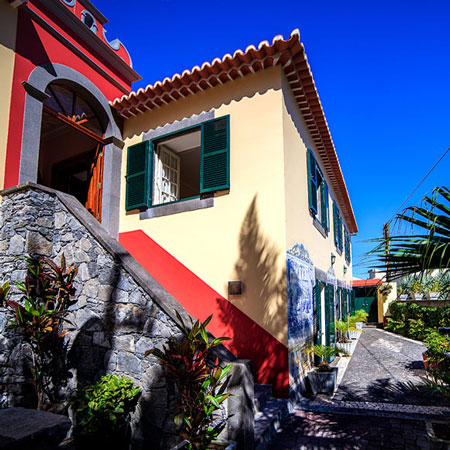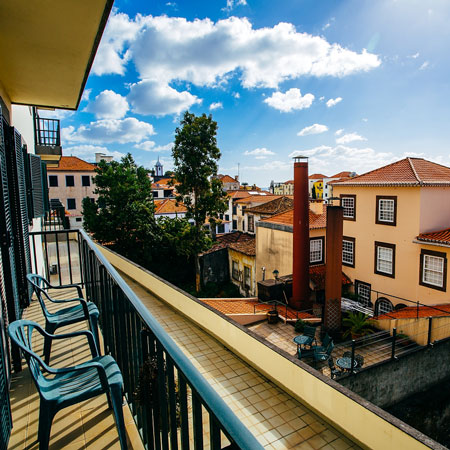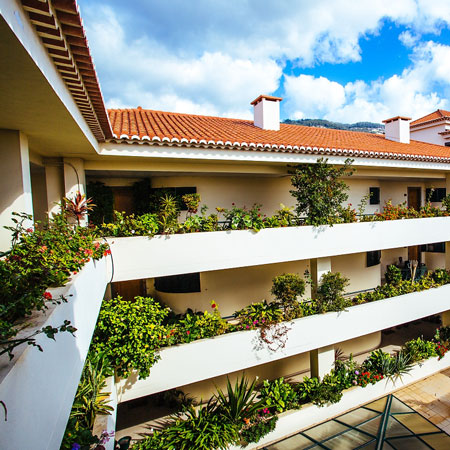In Madeira everything seems to work together to make a wide range of activities possible. This island is not only for the newly wed and the nearly dead. There is always a lot to do for any active grown up or even for dear-devilled teenagers. From the sea to the mountains, there are a myriad of possibilities in these enchanted islands. Here the clarity of the sea matches that of the air you breathe. You will walk on paths used by man at a time when there were hardly any roads, trails made whenever people wanted a short cut, or on the “levadas” hacked out by people of olden times in the rocks and mountain slopes, allowing them to carry water to where it was in short supply. When you walk on this amazing constructions, not only do you witness incomparable landscapes at every step, but you also tread the pages of history written by the dauntless Madeirans of old who, with daring and determination, forged links where Nature had neglected to do so.
While Madeira provides innumerable activities to be enjoyed in the open air, you have the added bonus of being able to do so close to the towns and villages, while still being able to walk great distances without encountering the more densely populated areas.
There is really no better testament to all of this than the feeling of contentment experienced by all who have the chance to travel to these magical islands and encounter Nature in this way. Nobody is untouched by it, that’s for sure.

Levadas
The “levadas” are waterways which run across the mountainsides, built by the early colonists to carry water to inaccessible farmland. Today they are one of the major tourist attractions of the island, another of its unique features.
Madeira has a fantastic network of tracks and “levadas”. In total there are over 200 of them crossing the basalt masses of the islands, leading the walker to a natural world such as is seldom seen elsewhere.
Along these water courses, rare species of flora and fauna can be found, from the world of the Madeiran Laurissilva forest, a primordial type of flora listed by UNESCO as a World Heritage site.
Birds such as the Long-toed Pigeon (Columba trocaz), Zino’s Petrel (Pterodroma madeira), the Madeira Chaffinch (Fringila coelebs maderensis) and the Madeira Firecrest (Regulus ignicapillus maderensis) can be found here, as well as trees such as the Fetid Laurel (Ocotea foetens), the Azorean Laurel (Laurus azorica) or the Indian Bay (Persea indica), as well as many other shrubs, plants and mosses found nowhere else in the world.
The majority of the walks are quite accessible, although they are graded according to difficulty, so it is a good idea to buy the programmes provided by travel agencies or the tourist organisations which arrange walks led by mountain guides and give advice as to the appropriate equipment to be used.
It goes without saying that you should tell people where you are going: under no circumstances should you do these walks alone, without telling anyone where you would be.
For more information, visit these websites:
http://www.madeira-adventure-kingdom.com/
http://www.walkmeguide.com/en/

Laurissilva, World Heritage
Madeira has the most extensive and best conserved Laurissilva-type floral region in the world. It covers an area of 14,953.7 hectares, all contained within the Madeira Nature Park as a Partial Nature Reserve and a Complete Nature Reserve.
The Reserve is a Special Protection Area that comes under the Wild Bird Management Organisation and is a Site of Community Interest governed by the Habitats Authority.
It has been listed as a Biogenetic Reserve by the Council of Europe since 1992 and was included in the World Natural Heritage List by UNESCO in December 1999.

Canyoning
This is the exiting sport that takes place in mountainous watercourses, where you will have to jump, swim and do rappels in the waterfalls and rivers. Madeira is known as one of the best sites in the world to do this sport, where emotions, feeling of mastering situations and exhilarating fun is the main theme. This is where you will get close and into the nature.
http://www.madeira-adventure-kingdom.com/

Tours
The decision to take a tour is a good option for anyone wishing to discover the island of Madeira at their ease, without having to drive, although these days this poses no problem, thanks to the modern roads linking the various locations.
There is a wide range of trips on offer through this gorgeous countryside, taking in everything from the charm of the tiny villages to everyday cosmopolitan life on Madeira.
The Madeira Tourist Board suggest the following tours: Eira do Serrado - Monte; Santana - Machico; Encumeada - Porto Moniz - Paul da Serra; and the island of Porto Santo There are, of course, many more. Visit a travel agent and you won’t waste time finding which trip best suits your interests.

Swimming
If one day you fancy having a swim and spending the day on the beach, Madeira has a lot to offer. Although it is an island, Madeira has few beaches of real sand. There is one natural one, Prainha, at Caniçal, on the southernmost tip of the island. Another two are found in Seixal, near Casa das Videiras. The typical beach on Madeira is made of round, black pebbles. It isn’t very comfortable to walk on, but it is genuine, shaped by Nature, which always loves variety.
Some beaches are situated farther off, around the island, others are close by. There are places where you can swim in fresh or salt water. Although you have to pay to use some of the beaches, the majority are free – they are treated as public amenities. Nowadays, as anywhere else in the world, you can hire sun beds and other equipment, for a set price, but it’s never very much.
There are a number of swimming venues very close to Casa das Videiras.
While you can swim just down from the house, you can also go a bit further afield. In the latter case, go a little further up the hill, past the church. You’ll find a sign pointing you towards the swimming pools. Take that path, and you won’t regret it.
There are also the natural swimming pools at Porto Moniz, which are very typical of the island.
If you want to go diving off a beautiful beach of yellow sand you may choose to take a day trip by boat to the island of Porto Santo. Here you will find nine kilometers of sand in a beautiful bay where the calm water invites you to take a carefree plunge.

Diving
Anyone enjoying the hospitality of Casa das Videiras who is interested in diving has an excellent array of options. Frankly, the entire coastline is at your back and call. However, because of Madeira’s relief, not far off-shore the sea-bed drops away quite sharply.
Although the sea temperature is not very cold for most of the year, the ideal season for diving is between April and December, at which time the sea around our coast is almost always warm.
For diving around the island, the best plan is to make arrangements with one of boats which sail from Funchal on different days.
You will also need a diving certificate. However, if you haven’t got one yet, you could contact one of the diving schools and do a course.

Whale and dolphin-watching
Whales and dolphins are often seen in the waters off Madeira Island. This is because not far from the coast the sea suddenly drops to a depth of 4,000 metres.
Great whales can be seen here the year round.
The island’s dolphins maintain their reputation for keeping the boats that travel over the sea company. They love to swim close to boats, skimming the water, endlessly leaping, or swimming along the surface..
Surfing
While Madeira may not have the huge rollers to be found in some other parts of the world, you can still get a very good ride here, both on and under the waves. Until quite recently Jardim do Mar (the Sea Garden) on the south coast of the island, just up from the Ribeira Brava, was the most popular venue. However, there has been some development on the seafront, which has made it slightly less delightful than it used to be.
There are, however, plenty more good spots on the island, such as between Seixal and Ponta Delgada, on the north coast.
Motor-boat and sailboat trips
If you want to get to know the coast of the island of Madeira from a vista similar to that of the mariners who discovered the island in 1420, there are a number of businesses which offer a range of different sailing experiences. You can even sail in a caravel, a replica of the Santa Maria, the ship in which Christopher Columbus sailed to America.
There are trips in the morning, evening trips so you can watch the sun set, dine and enjoy the night, or day-long trips.
The majority of the boats leave from Funchal Marina, right next to Funchal harbor.
Fishing
Fishing is available at almost any location on the coast around the island. There are only a few exceptions, mainly the protected zones, like the Garajau Nature Reserve.
If you want to go deep sea fishing, you should contact some of the businesses which organise this at Funchal Marina. Around Madeira there are also many large game fish which provide a challenge for even the most daring international sporting fishermen who head for the island determined to beat records.
In our opinion the sea around Madeira provides a kind of marine safari, where the species at the top of the list are the blue marlin or blue swordfish, but the albacore tuna is also important.

Bird watching
Thanks to Madeira’s natural characteristics and geographical location, the island is considered by specialists to be of particular interest to ornithologists, as proven by the existence of large colonies of sea and land bird species and subspecies which are to be found nowhere else in the world.
An extract from the writings of the Madeiran biologist Paulo Oliveira (of the Madeira Natural Park) refers to this very subject:
“The Madeira archipelago is blessed with an extremely interesting array of bird life. The larger groups or species of note are the sea birds, particularly Zino’s Petrel of Madeira and Bugio and the Long-toed Pigeon, then a range of Passeriforms such as the Madeira Chaffinch, the Madeira Firecrest and the Madeira Rock Sparrow. According to a publication issued in 1999 by the PNM (Madeira Nature Park), and in line with the IUCN (International Union for the Conservation of Nature) criteria, the archipelago has one highly endangered species, one endangered species, and 8 which are vulnerable and under management. In terms of legal protection, 19 of Madeira’s species are listed in the Birds Directive while 8 have been included in the annexes to the Berne Convention. With regard to habitat protection, we have 5 species which are found only in ZPEs (Special Protection Zones), 5 which mainly occur in ZPEs, while 29 are strongly represented in ZPEs.
The archipelago has 4 ZPEs, the Laurissilva Flora area, the Desertas islands, the Selvagens islands and the eastern Maciço Montanhoso, or Mountain Massif. All are complete or partial reserves under the jurisdiction of the PNM, the Madeira Nature Park, and are the target of management measures implemented by this body. The following are particularly important: habitat quality inventory, the monitoring of various species, the acquisition of a number of different flora areas, programs aimed at the eradication of various introduced species of flora and fauna and predator control programs, among others.
We are now in a position to confirm that we are coming out on top as regards the major challenges, and that the Madeira Nature Park, enjoying some tranquility thanks to the good work which has been done, is now in a position where programs are being organised and structured in such a way as to ensure that the efforts required for a Regional Nature Conservation Strategy have been maximized”.
Golf
The balmy climate of the two islands means that golf is a year-round activity here. Two golf courses have been built in the exceptionally beautiful landscapes of Madeira, while Porto Santo has one.Since 1993, Santo da Serra Golf Club has been playing host to the Madeira Open, at the start of Spring, an integral part of the PGA European Tour.This golf course is known as one of the most spectacular golf courses in Europe, not only because of the architecture of the course itself, but also thanks to the amazing vistas it affords, over mountain and sea.
This is a 27-hole golf course.
The other course is Palheiro Golf Club. This is in the mountains to the east of Funchal, and offers a staggering view over the bay and the city.
This is an 18-hole course.
http://www.madeira-golf.com
http://www.palheirogolf.com
http://www.santodaserragolf.com

Horse riding
If your taste is for horse riding, why not pay Associação Hípica da Madeira (Madeira Horse Riding Association) riding club at Quinta Vila Alpires (the Alpires Villa Estate) a visit? ,Located on the Pretos de Caminho Road, between Funchal and Camacha, you can take a course organised at different levels according to your experience. You can go on organised rides that are an amazing stress-buster, trotting through the lush, verdant countryside and a unique environment.
Ultra trail
Madeira is now on the world calendar for ultra trail. This increasingly more popular sport is attracting hundreds of international known athletes every year. Please see: https://www.facebook.com/madeiraultratrail

Other sports.
In Madeira you can do Para gliding, or rent a bike for mountain biking, BTT or downhill. It is also possibilities for coastering and mountain climbing.
Culture
The Madeira archipelago has a rich cultural heritage going back hundreds of years.
In the 15th and 16th centuries, thanks to its strategic position at the entrance to the Mediterranean, between Europe, Africa and America, the port of Funchal had trading links with the whole of Europe.
From that time on the island has garnered a rich cultural inheritance, protected in convents, churches, palaces, ancestral homes and military fortifications.







